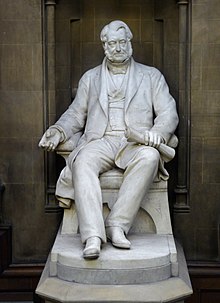Nicholas Wood
|
Nicholas Wood FRS |
|
|---|---|

The statue of Nicholas Wood in the library of The North of England Institute of Mining and Mechanical Engineers, Newcastle upon Tyne
|
|
| Born |
24 April 1795 Sourmires, Ryton, County Durham, England |
| Died | 19 December 1865 (aged 70) London, England |
| Resting place | Hetton-le-Hole, County Durham, England |
| Nationality | British |
| Spouse(s) | Maria Lindsay |
| Children | 4 sons, including Nicholas Wood (MP) and Sir Lindsay Wood, 1st Baronet |
| Parent(s) | Nicholas Wood, Ann Wood (née Laws) |
| Engineering career | |
| Discipline | Mining engineering, Locomotive engineering |
| Institutions | North of England Institute of Mining and Mechanical Engineers (inaugural president) |
| Projects | Newcastle and Berwick Railway |
| Significant advance | Mining safety |
Nicholas Wood FRS (24 April 1795 – 19 December 1865) was an English colliery and steam locomotive engineer. He helped engineer and design many steps forward in both engineering and mining safety, and helped bring about the North of England Institute of Mining and Mechanical Engineers, holding the position of President from its inauguration to his death.
Nicholas Wood was born at Sourmires, in the parish of Ryton, then in County Durham, the son of Nicholas and Ann (née Laws) Wood. Nicholas Senior was the mining engineer at Crawcrook colliery. Nicholas Junior attended the village school at Crawcrook and started work in 1811 at Killingworth Colliery as an apprentice colliery viewer under the guidance of Ralph Dodds. Wood eventually became the viewer, or colliery manager, of Killingworth Colliery in 1815. He was there a close associate of the colliery enginewright George Stephenson, helping him develop his version of the safety lamp and making considerable technical contributions to the development of his locomotive Blücher. Early in their career, George Stephenson began developing a revolutionary safety lamp, yet it was Wood, already an accomplished craftsmen, who made the drawing to which the "Geordie" lamp was made, under the supervision of the inventor. It was Nicholas Wood who actually designed the system of actuating the valves of Stephenson's Blücher with eccentrics added to the axle; most of the valve gears, including, ironically, the Stephenson Gear, were based on the use of eccentrics, however, not on the simple slip eccentrics of Wood. He also carried out in 1818 a series of experiments on rolling resistance, lubrication and laminated steel springs of locomotives. In 1823 he accompanied Stephenson to the meeting with Edward Pease in Darlington at which Pease was convinced to use locomotives on the and put Stephenson in charge of building it. Wood and Stephenson remained in close contact throughout their lives, and George Stephenson even sent his son, Robert Stephenson, to work as Wood's apprentice, where he flourished.
...
Wikipedia
